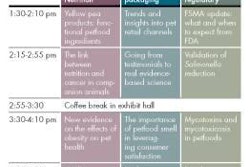
Open Innovation is a term promoted by Henry Chesbrough, a professor and executive director at the Center for Open Innovation at the University of California, Berkeley, in his book Open Innovation: The new imperative for creating and profiting from technology. The concept is related to user innovation, cumulative innovation, mass innovation and distributed innovation. According to Edwin Grim of Ralco Nutrition, “Open innovation is a paradigm that assumes that firms can and should use external ideas as well as internal ideas, and internal and external paths to market, as the firms look to advance their technology. The boundaries between a firm and its environment have become more permeable; innovations can easily transfer inward and outward."
In Grim's Petfood Forum Europe presentation, "Introduction to Open Innovation," he says the central idea behind open innovation is that in a world of widely distributed knowledge, companies cannot afford to rely entirely on their own research, but should instead buy or license processes or inventions (i.e., patents) from other companies. In addition, internal inventions not being used in a firm's business should be taken outside the company through licensing, joint ventures and spin-offs.
A petfood company should control the generation of their own ideas, as well as production, marketing, distribution, servicing, financing and supporting, according to Grim. This often means the company also creates their own research and development departments to be able to control the whole new product development cycle inside the company. Unfortunately, this often means there is no time to wait for the scientific community to become more involved in the practical application of science or enough time to wait for other innovative companies to start producing some of the components that were required in their conceptual product. With this traditional framework in place at many petfood companies, they become relatively self-sufficient with little communication directed outwards to other companies or universities. An environment meant to foster innovation can quickly become stagnant.
In 2012, open innovation makes much more sense than this old-school approach for new product development because of factors like:
- The increasing availability and mobility of skilled workers;
- The growth of the venture capital market;
- External options for ideas sitting on the shelf; and
- The increasing capability of external suppliers.
These four factors have resulted in a new market for knowledge, according to Grim's presentation. "I believe in being open minded, and crucial is whether a company can accept that the innovation point is the pivotal moment when talented and motivated people seek the opportunity to act on their ideas and dreams." The most innovative companies should understand the rewards of open innovation principles and realize the following benefits:
- A more robust product pipeline
- Accelerated speed to market
- Significant cost savings
- Access to global innovators across industries and technical disciplines
- Innovation sustainability
- Risk reduction
Innovative companies are also aware that there is no statistical relationship between R&D spending and sales growth, gross profit growth, operating profit growth, operating margin, net profit growth, net margin, market cap growth and total shareholder return (based on 10,000 analyses by Booz Allen, Global Innovation 1000, 2006). R&D staff often don’t know how or don’t have the authority to look beyond their own network, whereas R&D leaders know that access to technology is the main driver in being technologically innovative (see Table 1).
Open innovation is focused on obtaining tacit knowledge and applying it accordingly. In order to do this you may need to make appropriate changes to your current business model. This is far more important than getting a product to market first, says Grim. "Open innovation is serious business, so you have to determine what the value of an innovation is to you. Moreover, you should make it clear at the outset. When there is serious money involved, ask your colleagues if they really want to depend on solutions inside the company." Wouldn’t it be better to do both—inside and outside the company?
It’s also essential to ask yourself what you’re going to do once you get the appropriate response. Do you have budget, organization and other resources to implement the possibilities? Have you ever thought about patent issues? How do you negotiate with a good solution provider?
Realize as an organization who and what you are and where you want to go. Do you want to reach out to as many people as possible or are you looking for some very specific know-how?
Be assured that there are more solutions than you can imagine, but allow for failure, stay open for other sources, teach your sales force to ask the right questions and help young employees by asking questions to translate their observations into business issues and your company will be on its way to utilizing open innovation in a successful, profitable way.

















